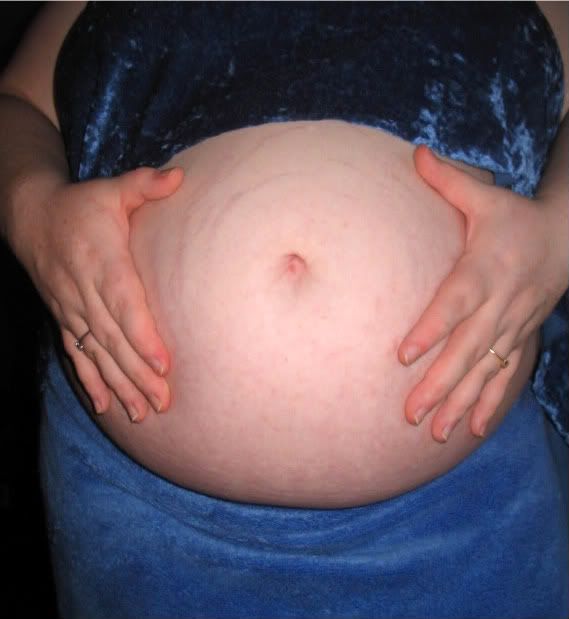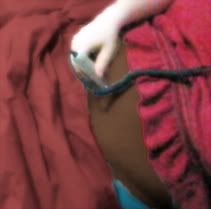 This is one of the biggest questions people ask about homebirth. It's based on the fear that is instilled into people from childhood that birth is painful and dangerous and that most women need rescuing from it.
This is one of the biggest questions people ask about homebirth. It's based on the fear that is instilled into people from childhood that birth is painful and dangerous and that most women need rescuing from it.Well, first, that's just not true. True emergencies only occur in about 5%-15% of births where a cesarean is required. I couldn't find an exact statistic for post-birth emergencies, but it's pretty low in general.
Now we're going to disregard pain control in this blog because that's not a part of the question. Women choosing homebirth in the US have already accepted that they wish to give birth without pain medications in most cases. They know that if they need them, a short trip to their nearest hospital can provide them. In the UK, mothers are provided with 'gas and air' (nitrous oxide) that they can control themselves. This option is currently not available to US mothers (despite many women "wishing" for it to be).
So, what happens if something goes wrong in a homebirth?
Now, midwives are not doctors. They are not surgeons. They cannot perform surgery and do not take high risk patients. Only normal pregnancies are taken on in the first place. Midwives watch for the pregnancy to continue normally and if something isn't right (such as placenta previa, pre-eclampsia, toxemia, etc.) then the mother's care will be transferred to an OB.
This works smoothly in countries where midwives are the default caretakers of mothers and homebirth is an easily obtained option. In the US, many midwives do work with OBs as backup to mimic the better model.
Midwives do not induce women with pitocin, artificially rupture their membranes and put them on a clock, either. These are some of the highest risk factors leading to cesarean births. (Some midwives do induce with herbs and sweep membranes, even though the second is shown not to be particularly effective and the first can be nearly as dangerous as pitocin induction.)
So, first, we've eliminated about 4-10% of necessary cesareans right there (approximately).
Now, that does leave some risk to homebirth (studies have shown that the risk of homebirth is no different from hospital birth, except those studies that did not eliminate accidental homebirth and those that included all births occurring outside of a hospital setting--some have even shown that homebirths are actually safer in 90% of normal pregnancies) as to ANY birth. So what happens if one of those risks occurs?
A midwife is there in labor specifically for that (in addition to catching the baby and some postpartum care). She watches the mother and baby for any sign that there is a need to transfer and in the event that she becomes concerned (and the reasons for this do vary by midwife--for type of midwife as well as her personal experience), then mother is transferred to the hospital as quickly as possible. If the hospital is not close by, the midwife may call it sooner than if the hospital is nearby.
Now, many people are afraid of the time that that takes. However, it is not significantly longer than the time it takes for a hospital to call in an anesthesiologist, back-up obstetrician and a neonatologist if necessary. That's right--not all hospitals have all of these staff members available at all times. Any woman in labor is at risk of needing an emergency cesarean when the anesthesiologist has stepped out for lunch (or gone to bed) or her OB doesn't have a second to assist (or no OB is even present in the hospital at the time--why do you think the nurses often page them frantically to get there while urging the woman not to push?).
In the event of an emergency, an ambulance will be called to stabilize mom (and baby if needed) and will call ahead to the hospital to make sure everyone is in place that is needed.
So, basically, the midwife does the same thing at home as she would in a hospital or birth center--only in the comfort of the mother's home.
In the end, homebirth is a safe and should be a valid, legal option for any woman who wishes to have one (just as birth centers and hospitals should be). Making them illegal is what puts women at risk, because they may wait longer to call for help when they need it, for fear of medical bullying or legal reprisal. And midwives are fully capable of recognizing the need to transfer care even during birth or after.
And yes, many midwives are capable of repairing tears and stopping bleeding as well and CNMs usually come with oxygen tanks in the even of the baby needing to be resuscitated or mother needing oxygen. They are also trained to deal with shoulder dystocia, cord prolapse, unresponsive newborns, hemorrhage and nuchal chords (where it's wrapped around the neck). Many are trained in breech birth as well. They are trained to handle most complications that arise and don't require an operating room or specialized equipment.
And finally, the difference between OBs and midwives:
An Obstetrician is a surgeon and a fully licensed doctor. Decades ago, they were taught to handle many more births vaginally than they now know how. Many forms of breech babies could be birthed vaginally and women would transfer to an OB for this service. Now, most OBs are no longer trained in this and are primarily trained in surgery.
There are different types of midwives.
First is the DEM or Direct Entry Midwife. "An independent practitioner who has learned midwifery through study, apprenticeship, a midwifery school, or a college program that is not a nursing program."
Then there are Licensed Midwives. "Midwives licensed to practice midwifery in a particular area. Normally a state. "
Next is the CPM or Certified Professional Midwife. "A midwife who has passed rigorous competency testing by the North American Registry of Midwives (NARM) is awarded a CPM certificate."
Finally, we have the CNM or Certified Nurse Midwife. "These women are trained as nurses and have done additional study in midwifery. Many are graduate students. They often offer complete prenatal care as well as attending births. "
CPMs and DEMs typically attend homebirth and though CNMs can, most work in hospital settings. CPMs also attend birth center births, as do CNMs.
So now you know a little more about what happens in a real emergency during a homebirth. It's still very rare, but protocols are in place and most women don't die even if they require a transfer, any more than they do in a hospital.

No comments:
Post a Comment
Please keep it civil and remember that my blog is not for debate. I have friends in all walks of life, so don't assume anything from individual posts! I do enjoy hearing from you, though :)